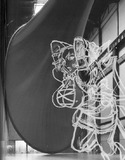| dc.rights.license | http://creativecommons.org/licenses/by-nc-sa/3.0/ve/ | |
| dc.contributor.author | De los Reyes, David | |
| dc.date.accessioned | 2009-07-21T17:50:16Z | |
| dc.date.available | 2009-07-21T17:50:16Z | |
| dc.date.issued | 2009-07-21T17:50:16Z | |
| dc.identifier.issn | Revs-0002 | es_VE |
| dc.identifier.uri | http://www.saber.ula.ve/handle/123456789/29027 | |
| dc.description.abstract | En múltiples ocasiones, Nietzsche es visto más como un filósofo que como un artista, sin embargo, este pensador cultivó la música a la par que reflexionaba sobre el mundo, de hecho, proponía un renacimiento en el arte de oír la música del mundo a través de la filosofía. Nietzsche encontraba en la música el único lenguaje para expresar lo que las palabras no podían en la naturaleza. En su juventud, Nietzsche halló en la música de Wagner una identidad y el reflejo anímico e intelectual de su vida, pero poco después, se separó del maestro debido a la impronta neocatólica y antisionista en su ética y estética, lo que permitió que Nietzsche condujera su espíritu y pensamiento hacia su propia concepción estética. Por otro lado, el
filósofo tenía claro que la música debía experimentarse tanto como una metafísica del ser como una reacción al absurdo de la existencia, es decir, más próxima a Dionisio que a Apolo. Es en este sentido en que Nietzsche vincula la música con la danza
dionisiaca, pues es posible pensar tal como se aprende a bailar una danza, en otras palabras, bailar con las ideas y el discurso mediante el poder terapéutico y emocional del ritmo. De esta manera, presenta su artista dionisiaco, aquel que crea por encima de la moral convencional; el que es capaz de transgredir lo establecido como arte. Para él, el músico está por encima del resto de los artistas. De allí que la música y la filosofía deben ser cultivados por músicos filósofos que conozcan la tristeza de la más profunda felicidad. | es_VE |
| dc.language.iso | es | es_VE |
| dc.rights | info:eu-repo/semantics/openAccess | |
| dc.subject | Música | es_VE |
| dc.subject | Estética | es_VE |
| dc.subject | Danza | es_VE |
| dc.subject | Metafísica | es_VE |
| dc.title | Nietzsche y la música | es_VE |
| dc.type | info:eu-repo/semantics/article | |
| dc.description.abstract1 | On numerous occasions, Nietzsche is seen more as a philosopher than as an artist, however, this thinker cultivated music at the same time reflecting on the world, in fact, proposed a renaissance in the art of hearing the music of the world through the philosophy. Nietzsche was in the music the only language to express what words could not in the wild. In his youth, Nietzsche found in the music of Wagner an identity and a reflection of mind and intellectual life, but shortly thereafter, was separated from the teacher because of the imprint neocatholic and anti-Zionist in his ethics and aesthetics, which allowed Nietzsche lead his spirit and thinking toward his own aesthetics. On the other hand, the philosopher was clear that music should be experienced both as a metaphysical being as a reaction to the absurdity of existence, or, closer to Dionysius that Apollo. It is in this sense that Nietzsche linking music with dance of Dionysius, as it is possible to think as you learn to dance a dance. In other words, dance with the ideas and speech through the therapeutic and emotional power of rythm. Thus, introducing his artist, who creates over conventional morality, which is able to transgress as established art. For him, the musician is above the rest of the artists. Hence, music and philosophy must be cultivated by philosophers musicians who know the sadness of the deepest happiness. | es_VE |
| dc.description.colacion | 54-61 | es_VE |
| dc.description.email | ddlreyes@cantv.net | es_VE |
| dc.description.frecuencia | semestral | es_VE |
| dc.identifier.depositolegal | 199702ME179 | es_VE |
| dc.subject.centroinvestigacion | Centro de Investigaciones Estéticas (CIE) | es_VE |
| dc.subject.facultad | Facultad de Humanidades y Educación | es_VE |
| dc.subject.keywords | Music | es_VE |
| dc.subject.keywords | Aesthetics | es_VE |
| dc.subject.keywords | Dance | es_VE |
| dc.subject.keywords | Metaphysics | es_VE |
| dc.subject.publicacionelectronica | Revista Estética | es_VE |
| dc.subject.thematiccategory | Artes y Humanidades | es_VE |
| dc.subject.tipo | Revistas | es_VE |
| dc.type.media | Texto | es_VE |



